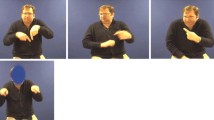Abstract
Eight children with developmental language impairment (LI) and eight age-, sex-, socioeconomic-status-, and I.Q.-matched controls were given tests of comprehension and expression of affective intent in spoken language and through facial expression. The LI children performed significantly more poorly than did controls in both comprehension and spontaneous expression of vocal affect. On tasks involving emotional facial expression, the opposite results were observed: The LI children were more dramatic in their expression of facial affect than were the controls. Children with language impairment appear to have a deficit in affective comprehension and expression that is modality-specific, i.e., limited to vocal affect. The heightened range of affective facial expression that they demonstrate may be a compensatory mechanism to offset their difficulties with vocal affect.
Similar content being viewed by others
References
Affolter, F., Brubaker, R., & Bischofberger, W. (1974). Comparative studies between normal and language disturbed children based on performance profiles.Acta Oto-Laryngologica, (Suppl. 323), 1–32.
Baker, L., & Cantwell, D. P. (1987). A prospective psychiatric follow-up of children with speech/language disorders.Journal of the American Academy of Child and Adolescent Psychiatry, 26, 546–553.
Berk, S., Doehring, D. G., & Bryans, B. (1983). Judgments of vocal affect by language-delayed children.Journal of Communication Disorders, 16, 49–56.
Cantwell, D. P., Baker, L., and Mattison, R. E. (1979). The prevalence of psychiatric disorder in children with speech and language disorder.Journal of the American Academy of Child and Adolescent Psychiatry, 18, 450–461.
Hollingshead, A. B. (1975),Four factor index of social status. Unpublished working paper.
Jernigan, T., Hesselink J. R., Sowell, E., & Tallal, P. A. (1991). Cerebral structure on magnetic resonance imaging in language- and learning-impaired children.Archives of Neurology, 48, 539–545.
Ross, E. D. (1981). The aprosodias: Functional and anatomic organization of the affective components of language in the right hemisphere.Archives of Neurology, 38, 561–569.
Ross, E. D., & Mesulam, M.-M. (1979). Dominant language functions of the right hemisphere? Prosody and emotional gesturing.Archives of Neurology, 6, 144–148.
Tallal, P., Dukette, D., Curtiss, S. (1989). Behavioral/emotional profiles of preschool language-impaired children.Development and Psychopathology, 1, 51–67.
Tallal, P., & Piercy, M. (1974). Developmental aphasia: Rate of auditory processing and seletive impairment of consonant perception.Neuropsychologia, 12, 83–93.
Tranel, D., Hall, L. E., Olson, S., & Tranel, N. N. (1987). Evidence for a right-hemisphere developmental learning disability.Developmental Neuropsychology, 3, 113–127.
Wechsler, D. (1974). Wechsler Intelligence Scale for Children-Revised. San Antonio: Psychological Corporation.
Weintraub, S., & Mesulam, M.-M. (1983). Developmental learning disabilities of the right hemisphere: Emotional, interpersonal, and cognitive components.Archives of Neurology, 40, 463–468.
Author information
Authors and Affiliations
Additional information
This work was supported by grant 12-203 from the March of Dimes Birth Defects Foundation, and by NINDS grant NS22343 for the Center for the Study of the Neurological Basis of Language.
Rights and permissions
About this article
Cite this article
Trauner, D.A., Ballantyne, A., Chase, C. et al. Comprehension and expression of affect in language-impaired children. J Psycholinguist Res 22, 445–452 (1993). https://doi.org/10.1007/BF01074346
Issue Date:
DOI: https://doi.org/10.1007/BF01074346




